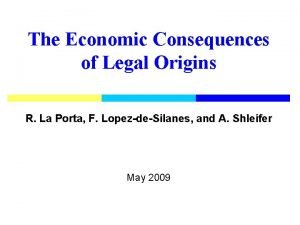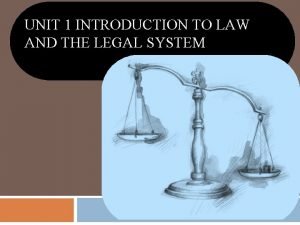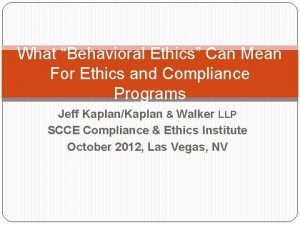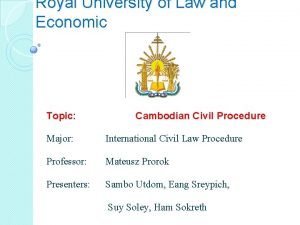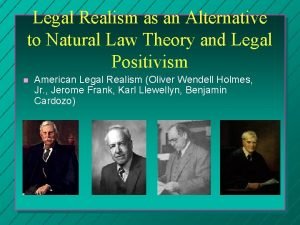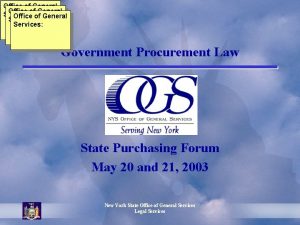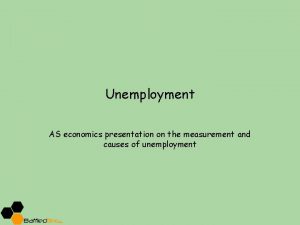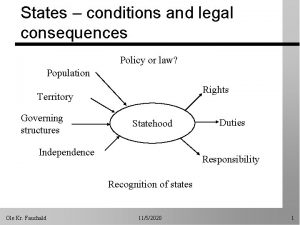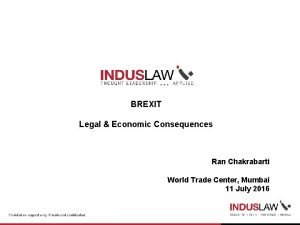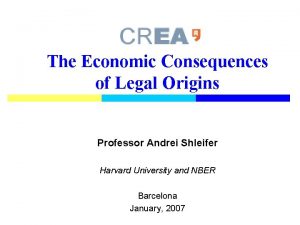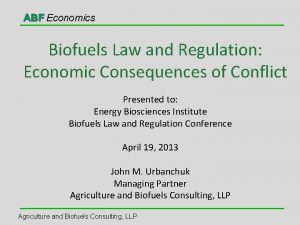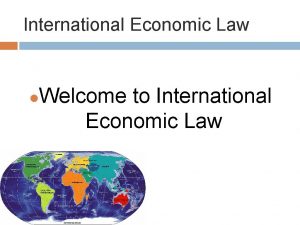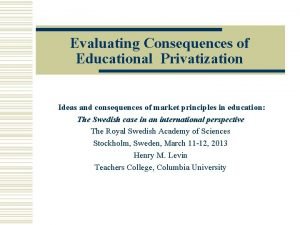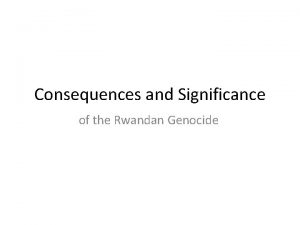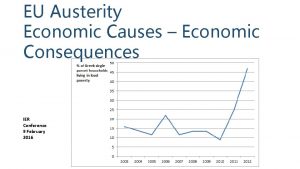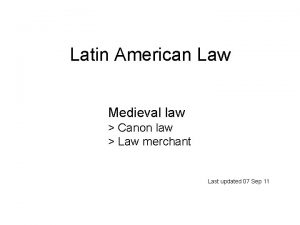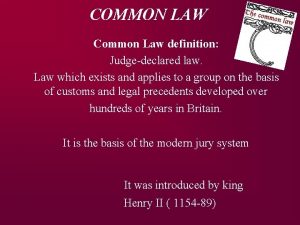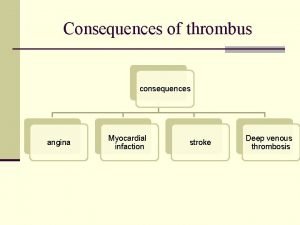Law and Finance The Economic Consequences of Legal





























- Slides: 29

Law and Finance The Economic Consequences of Legal Origins La Porta, Lopez-de-Silanes, Shleifer (and Vishny)

Structure • A. Law and Finance (1998) • B. The Economic Consequences of Legal Origins (2008) • C. Criticism 9/21/2018 Institutions and Development - Robert Hinz 2

I. Summary 1. Question and its importance • Legal rules, legal enforcement, effect of the rules • Different countries could have substantially different rules • Substantially different rules might explain differences in development • 4 legal families 9/21/2018 Institutions and Development - Robert Hinz 3

I. Summary 2. Method and main result • Comparative statistical analysis of 49 countries: • Laws protecting investors • Quality of law enforcement • Effect on corporate ownership • What is the main result? • Laws differ markedly within the legal families • Law enforcement differs significantly within the legal families • Countries develop substitute mechanisms for poor investor protection 9/21/2018 Institutions and Development - Robert Hinz 4

II. Paper’s question and contribution • What do we learn that we did not know before? • No systematic knowledge before (1998) • Substantially different rules might explain differences in financial patterns • How does the paper relate to economic theory? • Narrative: Weak investor protection laws actually make a difference • Poor investor rights and poor legal enforceability might come with a price 9/21/2018 Institutions and Development - Robert Hinz 5

III. Details of the paper • In what context do the authors test the hypothesis? • Comparative statistical analysis • Data from 1993 • Why is this a good experiment? • Large amount of data • Covers many countries • No focus on a single incident 9/21/2018 Institutions and Development - Robert Hinz 6

IV. Data 1. Countries • Which countries did the authors pick? • 49 countries from Europe, North and South America, Africa, Asia, Australia • No socialist or “transition” countries • Countries had at least five domestic nonfinancial publicly traded firms with no government ownership in 1993 9/21/2018 Institutions and Development - Robert Hinz 7

IV. Data 2. Variables • What data do the authors use? • Category 1: Shareholder rights • 7 different rights • e. g. : one-vote-one-share • Category 2: Creditor rights • 4 different rights • e. g. : management does not stay in reorganization 9/21/2018 Institutions and Development - Robert Hinz 8

IV. Data 2. Variables • What data do the authors use? • Category 3: Quality of legal enforcement and accounting standard • 5 + 1 variables • e. g. : risk of expropriation • Category 4: Ownership • 10 largest, domestic, totally private, publicly traded companies in each country • average and median of the combined ownership stake of the 3 largest shareholders of these companies 9/21/2018 Institutions and Development - Robert Hinz 9

IV. Data 3. Variation and economic theory • There is no variation to test the hypothesis • What is the measure of “strong” investor rights? • Number of some investor rights are counted within the legal families • Estimation of the quality of law enforcement and accounting standards • Ownership concentration of large companies is determined 9/21/2018 Institutions and Development - Robert Hinz 10

V. Results 1. Investor and creditor rights within the legal families • Hypothesis: Substantially different rules -> differences in financial patterns • 1. Common-Law Countries • 2. German-& Scandinavian-Civil-Law Countries • 3. French-Civil-Law Countries 9/21/2018 Institutions and Development - Robert Hinz 11

V. Results 2. Quality of law enforcement and accounting standards • Hypothesis: Strong legal enforcement could substitute weak rules • 1. German-& Scandinavian-Civil-Law Countries • 2. Common-Law Countries • 3. French-Civil-Law Countries 9/21/2018 Institutions and Development - Robert Hinz 12

V. Results 3. Ownership concentration • Hypothesis: Poor investor protection -> ownership concentration • 1. French-Civil-Law Countries • 2. Common-Law Countries • 3. German-& Scandinavian-Civil-Law Countries • Substitute mechanisms: Mandory dividends & legal reserve requirements 9/21/2018 Institutions and Development - Robert Hinz 13

V. Results 4. Summary • Laws differ markedly within the legal families • Law enforcement differs significantly within the legal families • Countries develop substitute mechanisms for poor investor protection / ownership concentration • Is the result consistent with economic theory? • Countries with good investor protection rights and/or good legal enforceability are the most developed 9/21/2018 Institutions and Development - Robert Hinz 14

Structure • A. Law and Finance (1998) • B. The Economic Consequences of Legal Origins (2008) • C. Criticism 9/21/2018 Institutions and Development - Robert Hinz 15

The Economic Consequences of Legal Origins (2008) 1. Summary • Follow-up paper • Legal Origin Theory • Addressed criticism 9/21/2018 Institutions and Development - Robert Hinz 16

II. Explanations of the differences of GB & FRA 1. Revolunary Explanations • Explanation derives from the different nature of the revolutions: • Glorious Revolution • French Revolution 9/21/2018 Institutions and Development - Robert Hinz 17

II. Explanations of the differences of GB & FRA 1. Revolunary Explanations • Consequences for legal origins • Built-in judicial independence of common-law –> more respect for private property • Common-law: „dispute-resolving“ • Civil-law: „policy-implementing“ • Common-law will be more adaptable to changing circumstances 9/21/2018 Institutions and Development - Robert Hinz 18

III. Legal Origin Theory • England Continental Europe (FRA) have developed very different styles of social control of business and institutions • Transplantation by the origin countries to most of the world • These styles have proved persistent in addressing social problems 9/21/2018 Institutions and Development - Robert Hinz 19

IV. Addressed Criticism 1. Reverse causality • Narrative: Countries improve rules as consequence of development • But: • Legal origins are still exogenous • Criticism doesn‘t reflect the significance of legal origins in shaping outcomes • Greenstone et al. (2006) Weakened this critism by analysing changes in financial development in response to change in legal rules 9/21/2018 Institutions and Development - Robert Hinz 20

IV. Addressed Criticism 2. Omitted variables • Narrative: Legal origins could influence financial development through some other channel (e. g. contract enforcement or quality of judiciary) • But: • Results are still significant if controlled for judiciary quality • La Porta et al. (2006) control for contract enforcement -> both are important • Further studies: Combination most effective 9/21/2018 Institutions and Development - Robert Hinz 21

IV. Addressed Criticism 3. Culture • Narrative: Legal origins are merely a proxy for culture • But: • Religion is not nearly as important as investor rights (Djankov et al. , 2007) • Most indices of cultural attitudes do not influence investor rights holding legal origin constant 9/21/2018 Institutions and Development - Robert Hinz 22

IV. Addressed Criticism 4. Politics • Narrative: Legal origins are merely a proxy for politics • But: • Results remain significant in autocracies and democracies 9/21/2018 Institutions and Development - Robert Hinz 23

IV. Addressed Criticism 5. History • Narrative: Legal origins are merely a proxy for (financial) history • But: • French-civil law countries had in 1913 more developed financial markets 9/21/2018 Institutions and Development - Robert Hinz 24

V. Main results 1. Four propositions 1. ) Legal rules and regulations differ systematically across countries 2. ) Legal origins account for these differences to a significant extent 3. ) Basic historical divergence in legal traditions explains why rules differ 4. ) Measured differences in legal rules matter for economic and social outcomes 9/21/2018 Institutions and Development - Robert Hinz 26

V. Main results 2. Recap Which institutions are responsible for financial development? “Legal origins have significant consequences for the legal and regulatory framework of the society, as well as for economic outcomes” 9/21/2018 Institutions and Development - Robert Hinz 27

Structure • A. Law and Finance (1998) • B. The Economic Consequences of Legal Origins (2008) • C. Criticism 9/21/2018 Institutions and Development - Robert Hinz 28

C. Criticism • “France and Belgium, after all, are both very rich countries” • There is no treatment, they are still different countries • “One” “legal family” • Variables (random, estimated) • Development before middle age 9/21/2018 Institutions and Development - Robert Hinz 29

Which institutions are responsible for financial development? “Legal origins have significant consequences for the legal and regulatory framework of the society, as well as for economic outcomes” 9/21/2018 Institutions and Development - Robert Hinz 30
 The economic consequences of legal origins
The economic consequences of legal origins Newton's first law and second law and third law
Newton's first law and second law and third law Newton's first law and second law and third law
Newton's first law and second law and third law Economic growth and development
Economic growth and development Ratesetter legal finance
Ratesetter legal finance Boyles law
Boyles law P=k/v
P=k/v Economic growth vs economic development
Economic growth vs economic development Economics unit 1 lesson 2 difficult choices
Economics unit 1 lesson 2 difficult choices Unit 1 introduction to law and the legal system
Unit 1 introduction to law and the legal system Examples of okonkwo’s heroic behavior
Examples of okonkwo’s heroic behavior Objective consequences
Objective consequences Choices poem
Choices poem What is sin and its consequences
What is sin and its consequences 5 unsafe attitudes and consequences
5 unsafe attitudes and consequences What is the relationship between choices and consequences
What is the relationship between choices and consequences Actions and their consequences examples
Actions and their consequences examples Romeo and juliet act 4 summary
Romeo and juliet act 4 summary Rising food prices causes and consequences
Rising food prices causes and consequences It is the appearance and feel of an event.
It is the appearance and feel of an event. Intrinsic rewards are psychic and self granted
Intrinsic rewards are psychic and self granted Rule university
Rule university Positive law vs natural law
Positive law vs natural law Legal aid maroochydore
Legal aid maroochydore Corporate finance law firm hong kong
Corporate finance law firm hong kong State finance law 163
State finance law 163 Unintended consequences
Unintended consequences Causes of unemployment
Causes of unemployment Blue earth county attorney
Blue earth county attorney Teenage alcohol consumption
Teenage alcohol consumption
